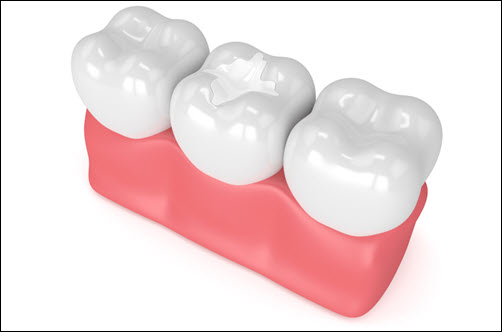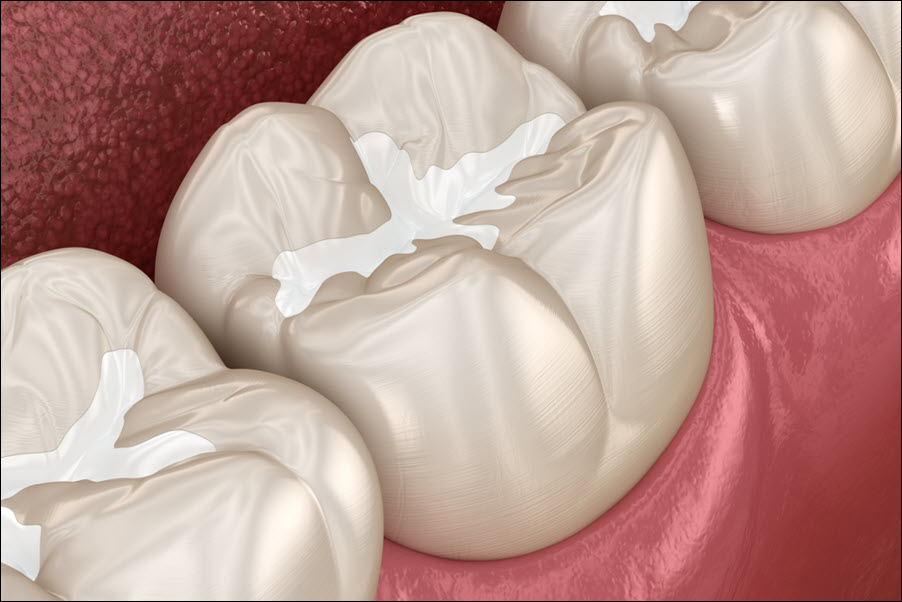Dental sealants protect teeth from cavities and decay. Dentists apply a thin plastic coating over the chewing surfaces of molars and premolars. Sealants create a barrier that blocks food particles and plaque from settling into deep grooves. This protective layer prevents bacteria from causing cavities and enamel erosion. Sealants are especially effective for children and teens, whose teeth are more prone to decay. Adults with deep grooves or cavity-prone teeth also benefit from sealants. The quick and painless procedure improves long-term tooth health and reduces the need for fillings. Understanding the benefits of dental sealants helps you protect your smile. Let’s explore how sealants improve dental health and prevent cavities.
What Are Dental Sealants?
 Dental sealants are thin, plastic coatings applied to the chewing surfaces of back teeth. Molars and premolars have deep grooves where food and plaque accumulate. Brushing and flossing often miss these hard-to-reach areas. Sealants fill the grooves and create a smooth surface, making cleaning easier. Dentists apply sealants using a painless process that takes about 30 minutes. The sealant material hardens under a special curing light, creating a protective shield. Once in place, sealants protect teeth from acids and bacteria that cause decay. Sealants are clear or tooth-colored, blending naturally with the teeth. They provide a long-lasting barrier against cavities and tooth damage.
Dental sealants are thin, plastic coatings applied to the chewing surfaces of back teeth. Molars and premolars have deep grooves where food and plaque accumulate. Brushing and flossing often miss these hard-to-reach areas. Sealants fill the grooves and create a smooth surface, making cleaning easier. Dentists apply sealants using a painless process that takes about 30 minutes. The sealant material hardens under a special curing light, creating a protective shield. Once in place, sealants protect teeth from acids and bacteria that cause decay. Sealants are clear or tooth-colored, blending naturally with the teeth. They provide a long-lasting barrier against cavities and tooth damage.
How Dental Sealants Prevent Cavities
Sealants protect teeth by blocking food particles and bacteria from settling into deep grooves. The smooth surface created by the sealant reduces plaque buildup and makes cleaning easier. Brushing and flossing alone often miss small pits and crevices in molars and premolars. Sealants create a barrier that prevents acids from weakening enamel and causing decay. Once sealed, the tooth surface becomes more resistant to cavities and bacterial growth. Sealants also reduce tooth sensitivity by shielding enamel from temperature changes and acid exposure. Protected teeth stay stronger and healthier for longer. Fewer cavities reduce the need for fillings and dental work.
The Dental Sealant Procedure
The sealant procedure is quick, painless, and non-invasive. The dentist starts by cleaning and drying the tooth surface. A mild acid solution roughens the enamel to help the sealant bond securely. The dentist applies the liquid sealant to the grooves of the tooth using a small brush. A curing light hardens the sealant within 30 to 60 seconds. The dentist checks the bite and adjusts the sealant if needed. The entire process takes about 30 minutes per tooth. Patients can eat and drink normally shortly after the procedure. Proper care extends the lifespan of sealants and improves tooth protection.
Benefits of Dental Sealants
Dental sealants reduce cavity risk by up to 80% in molars and premolars. Sealants protect enamel from acids and bacteria, reducing plaque buildup. They last between 5 to 10 years with proper care. Sealants reduce the need for fillings, root canals, and crowns. They improve chewing strength and reduce tooth sensitivity. Sealants also protect teeth from staining and discoloration. They require no drilling or anesthesia, making them ideal for children and nervous patients. Once applied, sealants strengthen enamel and improve overall dental comfort. Better tooth protection reduces long-term dental costs and increases smile confidence.
Who Should Get Dental Sealants?
Children and teens benefit most from sealants because their molars are more prone to cavities. Dentists recommend sealants once permanent molars erupt, usually between ages 6 and 12. Adults with deep grooves or a history of cavities also benefit from sealants. Patients with early signs of enamel erosion or tooth sensitivity improve tooth strength with sealants. Sealants provide extra protection for patients with orthodontic braces or dental appliances. High-risk patients, including those with dry mouth or weak enamel, benefit from added protection. Regular dental exams determine whether existing sealants need repair or replacement. Stronger, sealed teeth resist damage and decay longer.
Caring for Sealed Teeth
Brushing and flossing daily protect sealed teeth from plaque buildup. Use a soft-bristled toothbrush and fluoride toothpaste to clean the tooth surface. Avoid chewing on hard objects like ice and pens, which may damage the sealant. Floss gently between teeth to remove food particles and prevent gum inflammation. Regular dental checkups allow the dentist to monitor the condition of the sealant. Dentists repair or reapply damaged sealants to maintain protection. A balanced diet that limits sugary and acidic foods strengthens enamel and reduces decay risk. Consistent oral care increases sealant lifespan and improves overall dental health. Stronger teeth improve chewing and bite comfort.
Dental sealants protect teeth from cavities and plaque buildup. They cover deep grooves in molars and premolars, preventing food and bacteria from causing decay. The quick, painless procedure strengthens enamel and reduces tooth sensitivity. Sealants improve tooth durability and reduce the need for fillings and crowns. Children, teens, and adults with deep grooves or weak enamel benefit from sealants. Proper brushing, flossing, and regular dental checkups maintain sealant strength and effectiveness. Investing in dental sealants ensures long-term tooth protection and better oral health. Stronger, protected teeth create a healthier and more confident smile.

